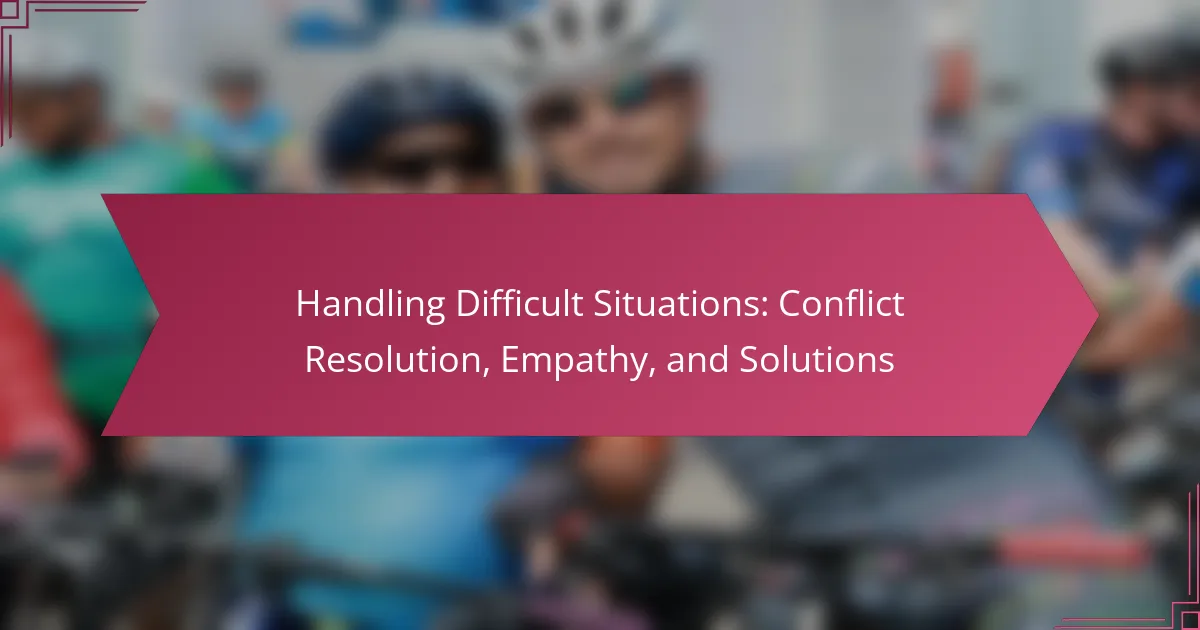Handling difficult situations requires a thoughtful approach to conflict resolution, emphasizing empathy and effective communication. By employing strategies such as active listening and collaborative problem solving, individuals can navigate disagreements constructively. Developing empathy not only enhances understanding but also paves the way for open dialogue, ultimately leading to mutually beneficial solutions.
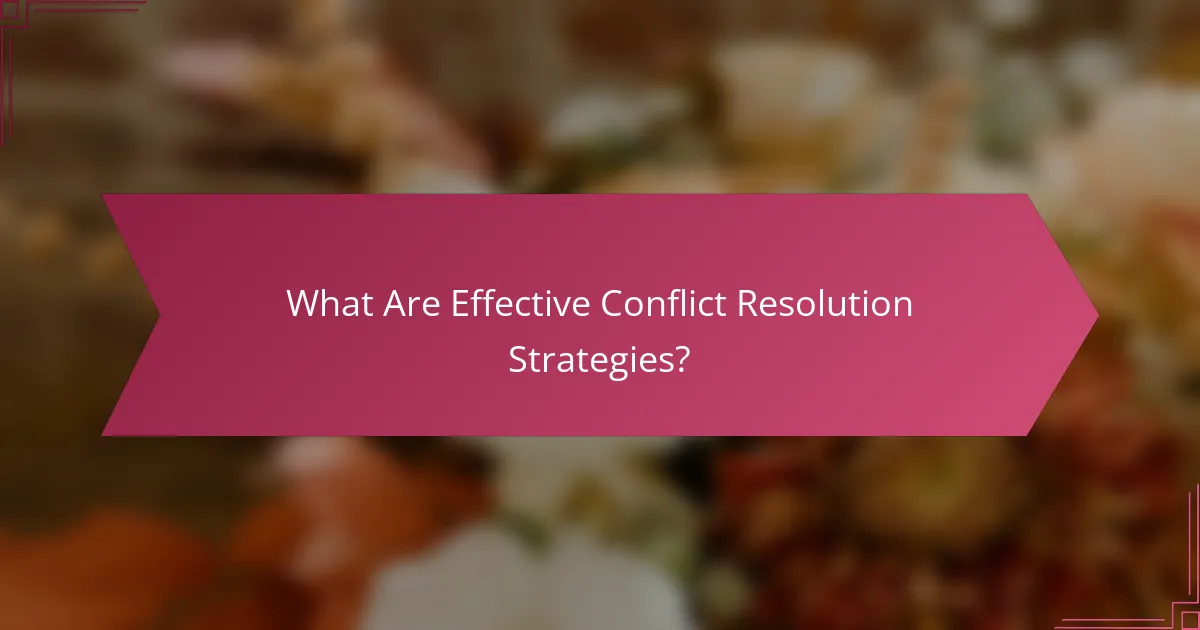
What Are Effective Conflict Resolution Strategies?
Effective conflict resolution strategies involve methods that help parties address disagreements constructively. Key approaches include mediation, active listening, collaborative problem solving, negotiation, and setting boundaries.
Mediation Techniques
Mediation techniques involve a neutral third party facilitating discussions between conflicting parties. This process encourages open communication and helps both sides express their viewpoints without interruption. A successful mediator remains impartial and guides the conversation towards a mutually acceptable solution.
Common mediation techniques include using open-ended questions to explore underlying issues and summarizing points to ensure understanding. For example, a mediator might say, “Can you explain how that made you feel?” to encourage dialogue.
Active Listening Skills
Active listening skills are crucial for resolving conflicts as they ensure that all parties feel heard and understood. This involves fully concentrating on the speaker, acknowledging their feelings, and responding thoughtfully. Practicing active listening can significantly reduce misunderstandings and foster a collaborative atmosphere.
To enhance active listening, maintain eye contact, nod in acknowledgment, and paraphrase what the other person has said. For instance, you might respond with, “What I hear you saying is that you felt overlooked during the meeting.” This clarifies the message and shows empathy.
Collaborative Problem Solving
Collaborative problem solving focuses on working together to find solutions that satisfy all parties involved. This approach emphasizes cooperation rather than competition, encouraging participants to share ideas and brainstorm options. It often leads to creative solutions that might not have been considered otherwise.
To implement collaborative problem solving, start by identifying shared goals and interests. Then, generate a list of potential solutions and evaluate each option together. This method can be particularly effective in team settings where ongoing relationships are important.
Negotiation Tactics
Negotiation tactics are strategies used to reach an agreement that benefits all parties. Effective negotiators prepare by understanding their own needs and the needs of others involved. They aim for win-win outcomes, where both sides feel satisfied with the resolution.
Key negotiation tactics include making the first offer to set the tone, using silence to encourage the other party to speak, and being willing to compromise. For example, if discussing a budget, propose a figure that allows room for negotiation while still meeting your essential needs.
Setting Boundaries
Setting boundaries is essential in conflict resolution to maintain respect and prevent future issues. Clear boundaries define acceptable behavior and help individuals communicate their limits effectively. This practice ensures that all parties understand what is and isn’t permissible in their interactions.
To set boundaries, communicate your needs directly and assertively. For instance, you might say, “I need to finish this project before we discuss our next steps.” This clarity helps others respect your time and priorities, reducing the potential for conflict.
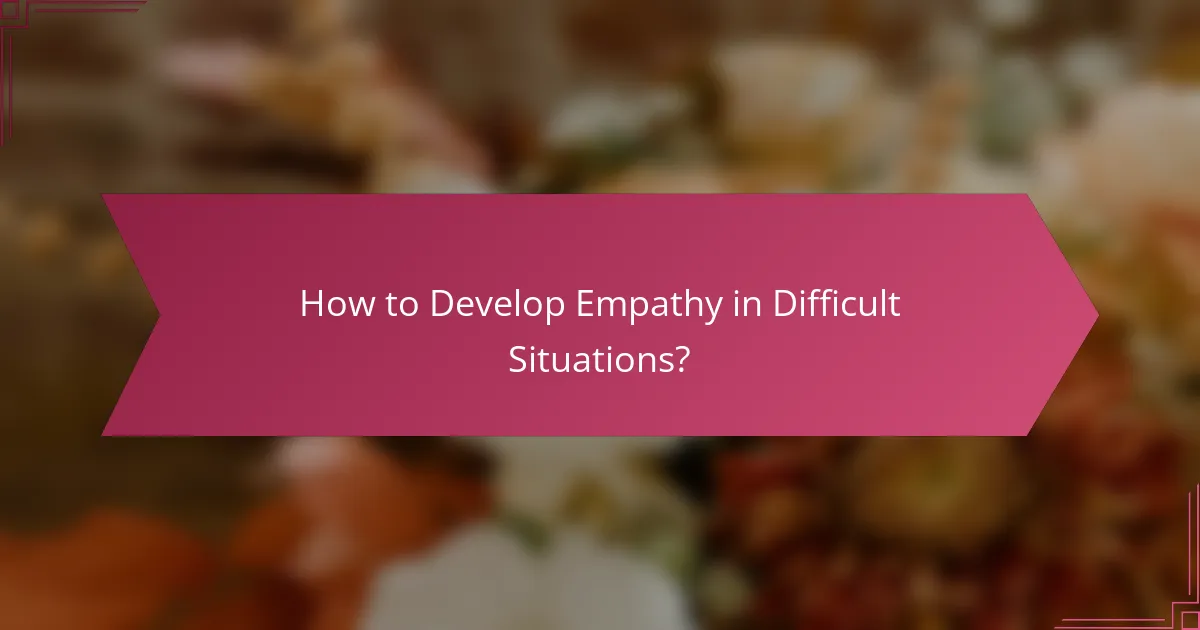
How to Develop Empathy in Difficult Situations?
Developing empathy in challenging situations involves actively listening and understanding the feelings and perspectives of others. This skill can enhance conflict resolution and foster more effective communication.
Understanding Perspectives
To truly understand perspectives, take the time to listen without interrupting. Ask open-ended questions that encourage others to share their thoughts and feelings, which can provide valuable insights into their viewpoints.
Consider using reflective listening techniques, where you paraphrase what the other person has said to confirm your understanding. This not only validates their feelings but also clarifies any misunderstandings.
Practicing Emotional Intelligence
Emotional intelligence is key in navigating difficult situations. It involves recognizing your own emotions and those of others, allowing you to respond appropriately rather than react impulsively.
To enhance your emotional intelligence, practice self-regulation by taking deep breaths or pausing before responding. This can help you manage your emotions and maintain a calm demeanor, which is essential in conflict resolution.
Building Rapport
Building rapport is crucial for effective communication during tough conversations. Start by finding common ground or shared interests, which can create a sense of connection and trust.
Use positive body language, such as maintaining eye contact and nodding, to show that you are engaged. Small gestures, like offering a genuine compliment, can also help in establishing a friendly atmosphere.
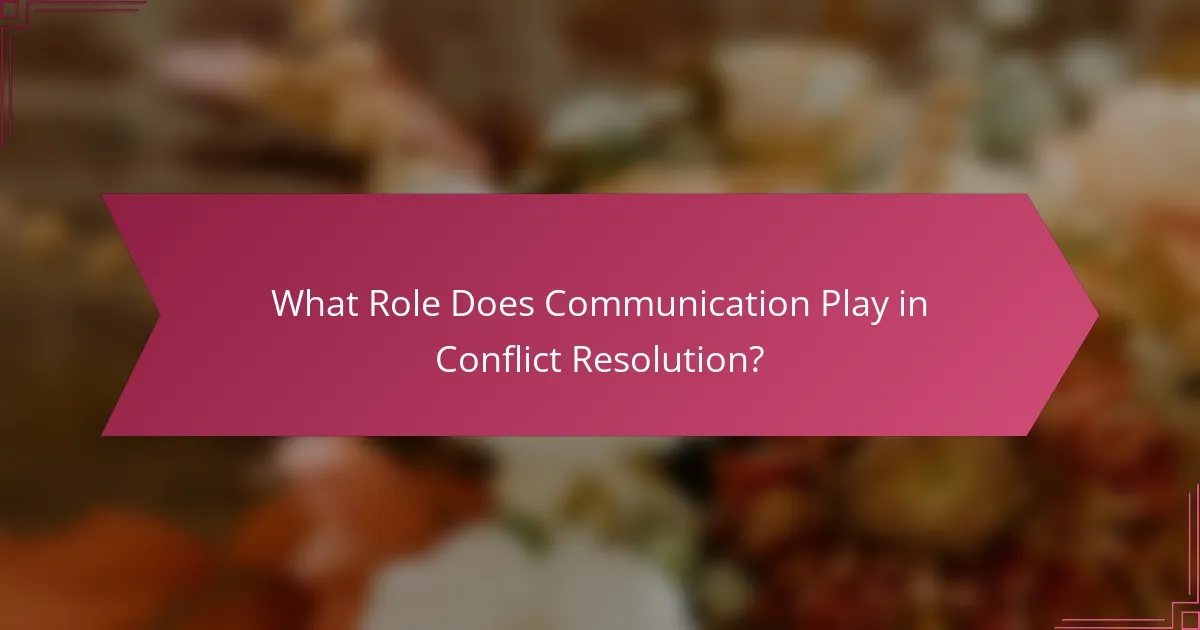
What Role Does Communication Play in Conflict Resolution?
Effective communication is essential in conflict resolution as it helps clarify misunderstandings and express differing viewpoints. By fostering open dialogue, parties can address issues directly and work towards mutually beneficial solutions.
Clear Expression of Needs
Clearly expressing needs is vital for resolving conflicts. When individuals articulate their desires and concerns, it reduces ambiguity and allows others to understand their perspective. For example, instead of saying “I’m unhappy,” one might say “I need more support with my workload,” which specifies the issue at hand.
To enhance clarity, use “I” statements to convey personal feelings without assigning blame. This approach encourages a constructive conversation rather than a defensive reaction.
Non-Verbal Communication Cues
Non-verbal communication plays a significant role in how messages are received during conflicts. Body language, facial expressions, and tone of voice can either reinforce or contradict spoken words. For instance, crossed arms may signal defensiveness, while an open posture can indicate willingness to engage.
Being aware of these cues helps individuals adjust their approach. Maintaining eye contact and using a calm tone can create a more inviting atmosphere for dialogue, fostering better understanding.
Feedback Mechanisms
Implementing effective feedback mechanisms is crucial for ongoing communication during conflict resolution. Regular check-ins allow parties to express how they feel about the progress being made and to adjust their strategies if necessary. This can be as simple as asking, “How do you feel about our discussion so far?”
Active listening is a key component of feedback. Paraphrasing what the other person has said demonstrates understanding and encourages further dialogue. Avoid interrupting and focus on the speaker’s message to ensure that all parties feel heard and valued.
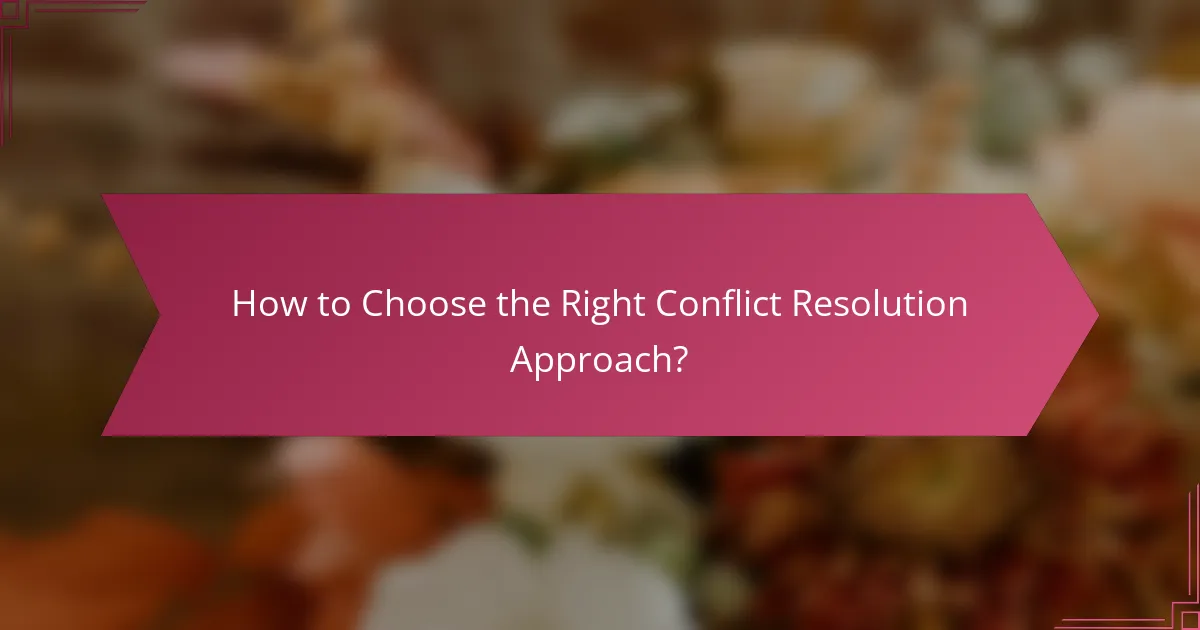
How to Choose the Right Conflict Resolution Approach?
Choosing the right conflict resolution approach involves understanding the nature of the conflict and the parties involved. Effective strategies can range from collaborative problem-solving to more directive methods, depending on the situation’s dynamics.
Assessing the Situation
Start by analyzing the conflict’s context, including the underlying issues and the emotional climate. Consider factors such as the severity of the disagreement, the history between the parties, and the potential impact on relationships and outcomes.
Gather information through observation and dialogue. This can help clarify the root causes and identify any biases that may affect perceptions. Use open-ended questions to encourage honest communication and gather diverse perspectives.
Identifying Stakeholders
Identify all parties involved in the conflict, including those directly affected and any bystanders who may influence the situation. Understanding each stakeholder’s interests and motivations is crucial for effective resolution.
Consider creating a stakeholder map to visualize relationships and power dynamics. This can help prioritize engagement and ensure that all relevant voices are heard, which is essential for a fair resolution process.
Evaluating Outcomes
Evaluate potential outcomes by considering the needs and goals of each stakeholder. Aim for solutions that address the core issues while fostering positive relationships among the parties involved.
Use criteria such as feasibility, acceptability, and sustainability to assess different resolution options. It may be helpful to brainstorm multiple solutions and weigh their pros and cons, ensuring that the chosen approach aligns with the stakeholders’ interests and long-term objectives.
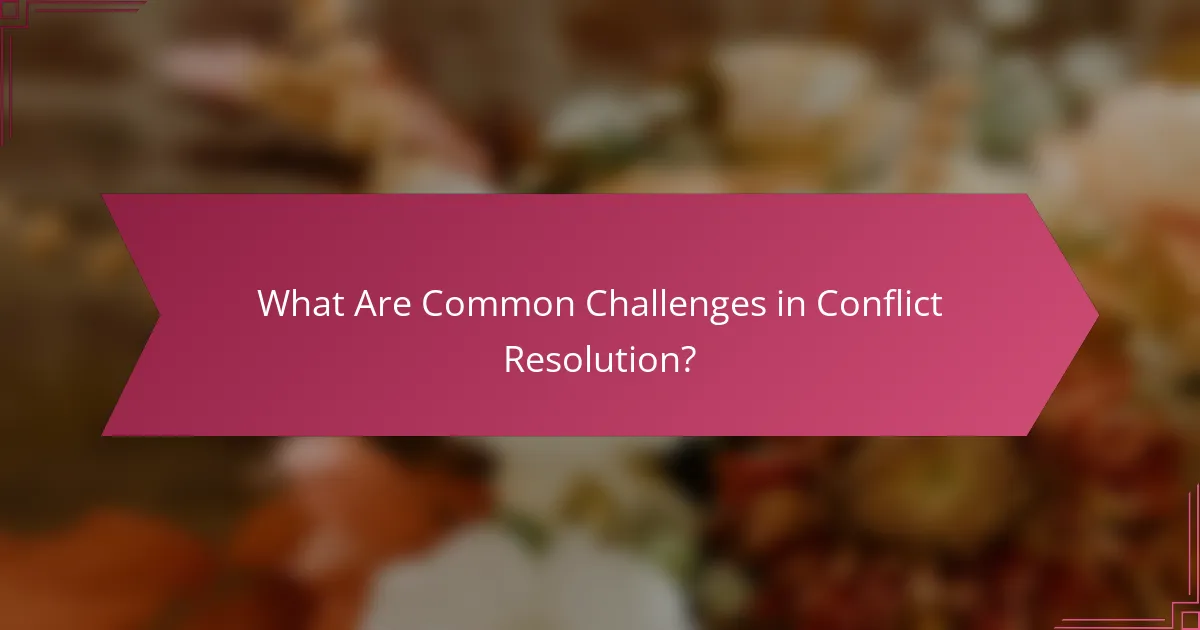
What Are Common Challenges in Conflict Resolution?
Common challenges in conflict resolution include emotional barriers, communication breakdowns, and differing interests. These obstacles can hinder effective dialogue and prevent parties from reaching a satisfactory agreement.
Emotional Barriers
Emotional barriers often arise from feelings such as anger, fear, or frustration, which can cloud judgment and escalate conflicts. When individuals are emotionally charged, they may struggle to listen or empathize with the other party’s perspective.
To navigate emotional barriers, it’s crucial to recognize and address these feelings early in the conversation. Techniques such as active listening and validating emotions can help de-escalate tensions and foster a more constructive dialogue.
For example, if a team member feels undervalued, acknowledging their contributions can reduce defensiveness and open the door to collaborative problem-solving. Avoiding personal attacks and focusing on the issue at hand can further mitigate emotional responses.
